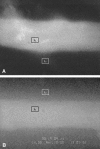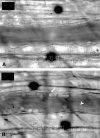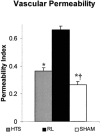Hypertonic saline resuscitation of hemorrhagic shock diminishes neutrophil rolling and adherence to endothelium and reduces in vivo vascular leakage
- PMID: 12409670
- PMCID: PMC1422622
- DOI: 10.1097/00000658-200211000-00014
Hypertonic saline resuscitation of hemorrhagic shock diminishes neutrophil rolling and adherence to endothelium and reduces in vivo vascular leakage
Erratum in
- Ann Surg. 2003 Jan;237(1):148
Abstract
Objective: To evaluate the in vivo effects of hypertonic saline (HTS) resuscitation on the interactions of endothelial cells (ECs) and polymorphonuclear neutrophils (PMNs) and vascular permeability after hemorrhagic shock.
Summary background data: The PMN has been implicated in the pathogenesis of EC damage and organ injury following hemorrhagic shock. Compared to Ringer's lactate (RL), HTS resuscitation diminishes PMN and EC adhesion molecule expression and organ sequestration of PMNs.
Methods: In a murine model of hemorrhagic shock (50 mmHg for 45 minutes followed by resuscitation) using intravital microscopy on cremaster muscle, the authors studied PMN-EC interactions and vascular leakage (epifluorescence after 50 mg/kg fluorescent albumin) in three resuscitation groups: HTS (shed blood + 4 cc/kg 7.5% HTS, n = 12), RL (shed blood + RL [2x shed blood volume], n = 12), and sham (no hemorrhage or resuscitation, n = 9). EC ICAM-1 expression was evaluated by immunohistochemistry. Data, presented as mean +/- SEM, were evaluated by analysis of variance with Bonferroni correction.
Results: There were no differences between groups in flow mechanics. Compared to RL, HTS animals (t = 90 minutes) displayed diminished PMN rolling and PMN adhesion to EC at time intervals beyond t = 0. There were no differences between the sham and HTS groups. Vascular leakage was 45% lower in HTS than in RL-resuscitated animals. Cremaster EC ICAM-1 expression was similar in the two groups.
Conclusions: Using HTS instead of RL to resuscitate hemorrhagic shock diminishes vascular permeability in vivo by altering PMN-EC interactions. HTS could serve as a novel means of immunomodulation in hemorrhagic shock victims, potentially reducing PMN-mediated tissue injury.
Figures







Comment in
-
Hypertonic saline: here we go again?Curr Surg. 2004 May-Jun;61(3):247-51. doi: 10.1016/j.cursur.2003.11.002. Curr Surg. 2004. PMID: 15165760 No abstract available.
Similar articles
-
Hemorrhagic shock resuscitation with a low molecular weight starch reduces neutrophil-endothelial interactions and vessel leakage in vivo.Surg Infect (Larchmt). 2001 Winter;2(4):275-87; discussion 287-8. doi: 10.1089/10962960152813313. Surg Infect (Larchmt). 2001. PMID: 12593703
-
Hypertonic saline resuscitation attenuates neutrophil lung sequestration and transmigration by diminishing leukocyte-endothelial interactions in a two-hit model of hemorrhagic shock and infection.J Trauma. 2003 Jan;54(1):121-30; discussion 130-2. doi: 10.1097/00005373-200301000-00015. J Trauma. 2003. PMID: 12544907
-
Hypertonic saline resuscitation of hemorrhagic shock does not decrease in vivo neutrophil interactions with endothelium in the blood-brain microcirculation.J Trauma. 2011 Aug;71(2):275-81; discussion 281-2. doi: 10.1097/TA.0b013e318226eb51. J Trauma. 2011. PMID: 21825927
-
Hypertonic saline and the microcirculation.J Trauma. 2003 May;54(5 Suppl):S133-40. doi: 10.1097/01.TA.0000064526.33647.63. J Trauma. 2003. PMID: 12768115 Review.
-
Role of permissive hypotension, hypertonic resuscitation and the global increased permeability syndrome in patients with severe hemorrhage: adjuncts to damage control resuscitation to prevent intra-abdominal hypertension.Anaesthesiol Intensive Ther. 2015;47(2):143-55. doi: 10.5603/AIT.a2014.0052. Epub 2014 Oct 8. Anaesthesiol Intensive Ther. 2015. PMID: 25293626 Review.
Cited by
-
Nebulized hypertonic saline attenuates acute lung injury following trauma and hemorrhagic shock via inhibition of matrix metalloproteinase-13.Crit Care Med. 2012 Sep;40(9):2647-53. doi: 10.1097/CCM.0b013e3182592006. Crit Care Med. 2012. PMID: 22732292 Free PMC article.
-
Can albumin administration relieve lung injury in trauma/hemorrhagic shock?World J Gastroenterol. 2006 Nov 14;12(42):6884-8. doi: 10.3748/wjg.v12.i42.6884. World J Gastroenterol. 2006. PMID: 17106942 Free PMC article.
-
Hypertonic Saline in the Treatment of Hemorrhagic Shock.Adv J Emerg Med. 2017 Oct 13;1(1):e8. doi: 10.22114/AJEM.v1i1.2. eCollection 2017 Fall. Adv J Emerg Med. 2017. PMID: 31172060 Free PMC article. Review.
-
Potentially Detrimental Effects of Hyperosmolality in Patients Treated for Traumatic Brain Injury.J Clin Med. 2021 Sep 14;10(18):4141. doi: 10.3390/jcm10184141. J Clin Med. 2021. PMID: 34575255 Free PMC article. Review.
-
Low-volume resuscitation with normal saline is associated with microvascular endothelial dysfunction after hemorrhage in rats, compared to colloids and balanced crystalloids.Crit Care. 2017 Jun 29;21(1):160. doi: 10.1186/s13054-017-1745-7. Crit Care. 2017. PMID: 28659186 Free PMC article.
References
-
- Velanovich V. Crystalloid versus colloid fluid resuscitation: a meta-analysis of mortality. Surgery 1989; 105: 65–71. - PubMed
-
- Nakayama S, Sibley L, Gunther RA, et al. Small-volume resuscitation with hypertonic saline (2,400 mOsm/liter) during hemorrhagic shock. Circ Shock 1984; 13: 149–159. - PubMed
-
- Shackford SR, Bourguignon PR, Wald SL, et al. Hypertonic saline resuscitation of patients with head injury: a prospective, randomized clinical trial. J Trauma 1998; 44: 50–58. - PubMed
-
- Velasco IT, Pontieri V, Rocha e Silva M Jr, et al. Hyperosmotic NaCl and severe hemorrhagic shock. Am J Physiol 1980; 239: H664–673. - PubMed
Publication types
MeSH terms
Substances
LinkOut - more resources
Full Text Sources
Miscellaneous

